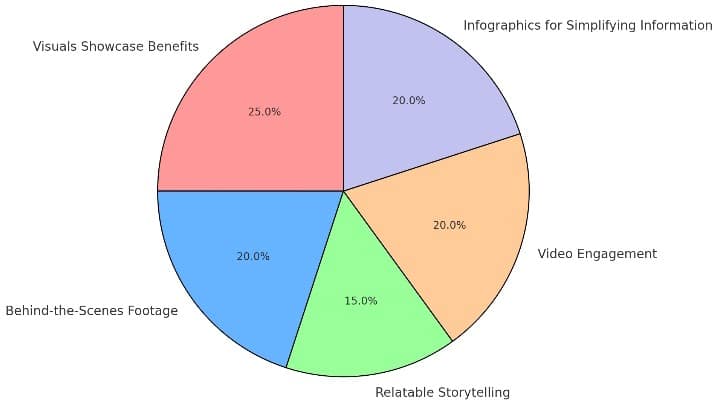Have you ever found yourself completely captivated by a brand story, one that made you feel an emotional connection to the product? I know I have. Product storytelling isn’t just about showcasing features—it goes beyond that.
Imagine transforming your products into heroes of their journeys, compelling customers to join the adventure. Well, I’ll share how you can use product storytelling to connect with your customers and at the same time increase sales. Trust me, keep reading because your marketing game is about to change!
Key Points
- Product storytelling involves creating a compelling narrative that highlights your product’s journey, purpose, and emotional connection with customers.
- Incorporate techniques like customer testimonials, relatable characters, and problem-solution frameworks to engage your audience effectively.
- Emotional storytelling helps foster trust, making your product more memorable and encouraging customers to form lasting connections.
- Consistency in messaging across various platforms ensures your product story resonates with your audience, building brand loyalty.
- Regularly assess and adjust your storytelling strategies to stay aligned with evolving customer expectations and industry trends.
How to Use Product Storytelling to Connect with Customers and Increase Sales
You will agree with me that there are lots of products in the market, and customers can be overwhelmed when faced with so many choices. With all these products vying for attention, a normal marketing campaign just isn’t enough anymore.
If you want to stand out and truly connect with your customers, you need to implement a product storytelling strategy. Below are some effective ways to use product storytelling to draw customers to your brand and boost sales.
# 1. Understand Your Audience
Understanding your audience is the cornerstone of telling a compelling story. It’s all about going deep into who they are and what they care about. First, know their needs, desires, and the challenges they encounter every day.
For instance, are they looking for solutions to specific problems? What motivates their decisions? When you have a clear picture of their lives, you can then write a narrative that speaks directly to them, making it relatable and engaging. I mean something they can relate to and understand perfectly well.
Directing your story to hit those emotional notes not only captures their attention but also fosters a stronger connection with your message. So, take the time to get to know your audience—it’s well worth the effort. Also read these articles:
Audience Targeting: What It Is, Why You Need It and Best Tools to Use
Best Strategies for Captivating Your Audience with Social Media Storytelling (+ Examples)
#2. Create a Relatable Character
Every good story has a hero, and in this case, that hero could be your customer. Imagine sharing the story of someone who’s trying to get fit. They might start off feeling overwhelmed, struggling to find the motivation and the right gear to help them on their journey.
By introducing your fitness gear in this story, you show how it transforms their experience. Maybe they discover your product helps them feel more comfortable during workouts or gives them that extra boost of confidence. As potential buyers read this journey, they can envision themselves in similar shoes, facing their challenges and dreaming of success.
This approach not only shines a light on your product but also makes it relatable and inspiring. It’s a simple yet effective way to engage your audience and help them see how your product can be a game-changer in their lives.
# 3. Highlight Problems and Solutions
Another key component of storytelling is conflict, which in marketing translates to the problems your customers face. When you’re telling a story in marketing, think of it as a journey where your customers face certain hurdles along the way. These hurdles are the real-life problems they encounter daily—whether it’s time management, health issues, or financial concerns.
Now, when you highlight these challenges, it draws your audience because they can see themselves in that narrative. For example, if you’re selling a time-management app, you can start by illustrating a common struggle: the overwhelming feeling of a packed schedule that leaves little room for personal activities.
Once you’ve laid out the problem, it’s time to shine a light on your product as the hero of this story. You can say something like, “Imagine using our app to not only organize your tasks but also to reclaim those precious hours you thought were lost for good.” If you do this, you’re not just selling a product; you’re offering a tangible solution that transforms their lives for the better.
This storytelling technique not only keeps your audience engaged but also helps them visualize how your product can solve their problems. Then, make your message more memorable and effective.
#4. Use Authentic Testimonials
I remember the first time I stumbled upon a testimonial that attracted me. It was from a fellow customer who had experienced an incredible transformation after using a product I was curious about. They shared their journey in such a relatable way—how they struggled initially, but after incorporating this product into their routine, they saw amazing results.
Hearing their story made me feel like I wasn’t alone in my challenges. It increased my trust in the brand, and I decided to give it a try. Honestly, a few weeks later, I was sharing my own success story, feeling just as grateful and excited.
For this reason, I must say that real experiences like these not only build credibility but also create a sense of community around a brand. So, if you want to try something new, just remember that countless people have walked the same path and found joy in the journey—just like you might too.
#5. Create a Visual Narrative
Creating a visual narrative can truly bring your brand to life. Imagine scrolling through social media or visiting a website where vibrant images and engaging videos instantly capture your attention. I’ve found that using striking visuals not only showcases the benefits of my products but also helps communicate my brand’s story in a relatable way.

For instance, I often share behind-the-scenes footage of my business, allowing customers to connect with the people and processes that make my product special. It’s incredible how a short video can convey the passion and care that go into each item, making the image message easier to digest and way more engaging.
Plus, infographics can distill complex information into bite-sized pieces, making it accessible to everyone. In essence, storytelling through visuals is not just an option; it’s a necessity.
Best Product Storytelling Examples
When I think about the best product storytelling examples, a few stand out to me. Take Apple, for instance. They don’t just sell tech; they sell a lifestyle. Their ads often focus on how their products enhance creativity and connection, which really resonates with consumers.
Another example is Nike. Their “Just Do It” campaign features inspirational stories of athletes overcoming obstacles. Instead of just promoting shoes, they tell stories of passion and perseverance, making their brand feel relatable and motivating.
I also love how Airbnb shares stories from hosts and travelers. They showcase real experiences that highlight the unique connections and adventures people have, which makes you feel like you’re part of something bigger.
Lastly, I’ve noticed how Coca-Cola uses storytelling around shared moments. Their campaigns often feature joyful gatherings, focusing on connection and happiness. I am sure this is one of the things that made you purchase their product with positive vibes.
These brands excel so much in storytelling, which engages their audience and creates an emotional bond. Hence, making their products much more than just items on a shelf.
For more information read:
Video Storytelling: Its Benefits to Your Brand
13 Digital Storytelling Examples that Will Inspire You
How To Do Product Storytelling?
Product storytelling is all about connecting your audience to your brand and product through engaging narratives. First, identify the core message you want to convey and the emotions you want to evoke. Think about who your audience is and what their needs or aspirations are.
Instead of just listing features, write a story highlighting how your product fits into their lives, solving problems or enhancing their experiences. Use relatable characters and scenarios to make the narrative more engaging; your audience can see themselves in the story.
Finally, remember to keep it authentic—people connect more with genuine tales that reflect the true essence of your brand. When done right, product storytelling can turn potential buyers into loyal fans. Also, download the checklist below for more information!
Essential Steps to Build Your Product Storytelling Strategy
What Are The 4 Cs Of Storytelling?
The 4 Cs of storytelling are essential elements that boost a compelling narrative, and they bring a story to life. They are character, conflict, change, and context.
- Character is the heart of any story. They are the individuals—human, animal, or even object—through whom the audience experiences the narrative. Great characters are relatable and often face challenges that connect with our own experiences.
- Conflict is the driving force of any story—essentially, it’s what creates tension. This arises when the character faces obstacles, whether those are internal struggles, external challenges, or a combination of both. So, without conflict, a story can feel flat and uninteresting.
- Change highlights the growth or shifts that characters undergo throughout the story. It can be transformative, showing how a character evolves due to their experiences, or it can be about the situation in the larger world of the story. In essence, a strong narrative often showcases significant change, making it memorable and impactful.
- Context refers to the setting—where and when the story takes place. This shapes the environment and influences the characters’ actions and decisions, grounding the story in a relatable framework that draws the audience.

When you bring these four elements together—character, conflict, change, and context, you create a rich work that draws readers in and keeps them engaged. I call the 4 Cs the secret sauce for great storytelling
What Are The 5 Ps Of Storytelling?
The 5 Ps of storytelling are People, Place, Pictures, Personalisation, and Peril. I know you might be wondering what they entail. Well, here’s a brief breakdown of what each element means:
- People: Every great story revolves around characters. These are the heroes, villains, and everyone in between. Relatable and well-crafted characters draw audiences in and make them care about the journey.
- Place: The setting provides the backdrop for your narrative. So, whether it’s a bustling city, a quiet village, or an otherworldly realm, the place sets the mood and enhances the story’s themes.
- Pictures: This refers to the imagery and vivid descriptions that bring the story to life. It’s all about painting a mental picture for your audience, making them feel as though they’re part of the action.
- Personalization: This is where you connect the story to your audience’s emotions and experiences. When readers or listeners see themselves in the story, they’re more likely to be engaged and invested.
- Peril: Finally, every captivating story needs some form of conflict or challenge. Peril can be a physical danger, emotional struggle, or moral dilemma. This tension keeps the audience on the edge of their seats, eagerly wanting to know what happens next.
What Does A Product Story Look Like?
A product story is like a narrative that explains the journey of a product from its conception to its current form, highlighting its value, purpose, and the experience it brings to customers. It gives context to the product, making it relatable and memorable.
For example, think of a handcrafted mug. The product story might begin with the artisan in a small town, who draws inspiration from the surrounding nature. The artisan talks about how each mug is carefully shaped by hand, ensuring that no two mugs are alike. This personal touch connects customers to the craft and the artist’s vision.
Therefore, when someone buys the mug, they’re not just getting a drinking vessel; they’re taking home a piece of art and a story—perhaps to enjoy their morning coffee while feeling inspired by the artisan’s creativity.
In summary, a product story adds depth to a simple item, making it attract people on an emotional level.
Related Articles
How I Use the StoryBrand Framework to Create Compelling Brand Stories: A Complete Guide
My 7 Best Tips for Building Compelling Storytelling Marketing Strategies for Brands in 2024
What Is Brand Storytelling and Why It Matters for Your Brand (+ Examples & Templates)






